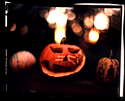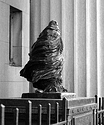There was a thread here some time ago about chloride rehal bleach and the consensus was that chloride bleach killed the highlights in a print. Is this problem still there or was there some solution to this? Or maybe the nitric acid is the solution?
It's not so much that any bleach / toner kills the highlights rather that the overall Dmax of a very warm toned yellow/brown print has a very significant drop in density across all the tones.
If you redevelop a print bleached in a simple rerricyanide/chloride or ferricyanide/bromide based bleach it should return to the same density, hover add something like Nitric acid, Ammomia maybe as you suggest Bisulphate then you interfer with the simple rehalogenation process adding the pprobability that some silver is dissolved may diffuse slightly in the print emulsion before being converted to halide again, this gives the finer grain whin in turn results in warmer tones.
Remember that another variable in bleaches is the excess or lack of excess of the halide, so Agfa 500 uses a ratio of 15:1 Ferricyanide to Bromide while 501 uses a 5:1 ration (ratios by weight). If there's no excess of halide in the bleach then Silver Ferricyanide complexes are formed which are less stable and will reduce theeffects of the subsequent toner.
In this case the ratio is closer to the 1:1 used in a typical Bleach such as used in Ilford IT-1or Kodak T-52 & T-56, so great excess of halide but with a silver solvent present.
Because of the overall density loss many toners require over exposer at the printing stage to compensate.
Ian





 Apparently the nitric acid reacts with an amino acid in your skin and produces a yellow dye. If it's left on long enough, the top layer becomes less skin-like and more paper-like.
Apparently the nitric acid reacts with an amino acid in your skin and produces a yellow dye. If it's left on long enough, the top layer becomes less skin-like and more paper-like. But, it peels off.
But, it peels off.